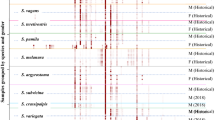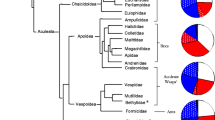Abstract
Colonies ofZootermopsis were collected from the central Sierra Nevada and the Monterey Penninsula in California, and from southern Arizona. Cuticular hydrocarbons were identified by gas chromatography-mass spectrometry (GC-MS) and quantified by gas-liquid chromatography (GLC) for each caste of all colonies. Four consistent and distinct cuticular hydrocarbon patterns, or chemical phenotypes, were identified. Unique and abundant monomethyl- and dimethylalkanes, and ann-alkene provided easy separation of the various phenotypes. Significant differences in the proportions of the various components were found among castes within a colony and colonies within phenotypes from California. Differences in the hydrocarbon proportions for castes were not consistent between colonies. The current taxonomy of the genusZootermopsis recognizes three species. Our identification of four consistent, unique cuticular hydrocarbon phenotypes from the three described species should alert systematists and others to a major concern. If there are truly only three extant species, then the hypothesis that cuticular hydrocarbon profiles in this genus are species specific is not acceptable. Conversely, if cuticular hydrocarbon profiles are truly species specific, then there is at least one new, undescribed species ofZootermopsis.
Similar content being viewed by others
References
Banks, N., andSnyder, T. E. 1920. A revision of the Nearctic termites.Bull. U.S. Nat. Mus. 108:1–228.
Blomquist, G. J., andDillwith, J. W. 1985. Cuticular lipids, pp. 117–154,in G. A. Kerkut and L. I. Gilbert (eds.). Comprehensive Insect Physiology, Biochemistry and Pharmacology, Vol. 3. Integument, Respiration and Circulation. Pergamon, Oxford.
Blomquist, G. J., Howard, R. W., andMcdaniel, C. A. 1979. Structure of the cuticular hydrocarbons of the termiteZootermopsis angusticollis (Hagen).Insect Biochem. 9:371–374.
Blomquist, G. J., Howard, R. W., Mcdaniel, C. A., Remaley, S., Dwyer, L. A., andNelson, D. R. 1980. Application of methoxymercuration-demercuration followed by mass spec-trometry as a convenient microanalytical technique for double-bond location in insect-derived alkenes.J. Chem. Ecol. 6:257–269.
Emerson, A. E. 1933. A revision of the genera of fossil and recent Termopsinae (Isoptera).Univ. Calif. Publ. Entomol. 6:165–196.
Hadley, N. F. 1980. Surface waxes and integumental permeability.Am. Sci. 68:546–553.
Hadley, N. F. 1985. The Adaptive Role of Lipids in Biological Systems. John Wiley & Sons, New York.
Howard, R. W., andBlomquist, G. J. 1982. Chemical ecology and biochemistry of insect hydrocarbons.Annu. Rev. Entomol. 27:149–172.
Howard, R. W., Mcdaniel, C. A., andBlomquist, G. J. 1978. Cuticular hydrocarbons of the eastern subterranean termite,Reticulitermes flavipes (Kollar) (Isoptera: Rhinotermitidae).J. Chem. Ecol. 4:233–245.
Howard, R. W., Mcdaniel, C. A., andBlomquist, G. J. 1980. Chemical mimicry as an integrating mechanism: Cuticular hydrocarbons of a termitophile and its host.Science 210:431433.
Howard, R. W., Mcdaniel, C. A., Nelson, D. R., Blomquist, G. J., Gelbaum, L. T., andSalkow, L. H. 1982. Cuticular hydrocarbons as possible species and caste-recognition cues inReticulitermes sp.J. Chem. Ecol. 8:1227–1239.
Jackson, L. L., andBlomquist, G. J. 1976. Insect waxes, pp. 201–233,in P. E. Kolattukudy (ed.). Chemistry and Biochemistry of Natural Waxes. Elsevier, Amsterdam.
Moore, B. 1969. Biochemical studies in termites, pp. 407–432,in K. Krishna and F. M. Weesner (eds.). Biology of Termites, Vol. I. Academic Press, New York.
Nelson, D. R. 1978. Long-chain methyl-branched hydrocarbons: Occurrence, biosynthesis and function.Adv. Insect Physiol. 13:1–33.
Nelson, D. R., Sukkestad, D. R., andZaylskie, R. G. 1972. Mass spectra of methyl-branched hydrocarbons from eggs of the tobacco hornworm.J. Lipid Res. 13:413–421.
Pomonis, J. G., Fatland, C. F., Nelson, D. R., andZaylskie, R. G. 1978. Insect hydrocarbons. Corroboration of structure by synthesis and mass spectrometry of mono- and dimethylalkanes.J. Chem. Ecol. 4:27–39.
Snyder, T. E. 1954. Order Isoptera. The termites of the United States and Canada. National Pest Control Association, New York.
Sumner, E. C. 1933. The species of the termite genusZootermopsis Emerson (=Termopsis Hagen).Univ. Calif. Publ. Entomol. 6:197–230.
Weesner, F. M. 1965. The Termites of the United States, A Handbook. National Pest Control Association, Elizabeth, New Jersey.
Weesner, F. M. 1970. Termites of the Nearctic region, pp. 477–525,in K. Krishna and F. M. Weesner (eds.). Biology of Termites, Vol. II. Academic Press, New York.
Author information
Authors and Affiliations
Additional information
Isoptera: Termopsidae.
Rights and permissions
About this article
Cite this article
Haverty, M.I., Page, M., Nelson, L.J. et al. Cuticular hydrocarbons of dampwood termites,Zootermopsis: Intra- and intercolony variation and potential as taxonomic characters. J Chem Ecol 14, 1035–1058 (1988). https://doi.org/10.1007/BF01018791
Received:
Accepted:
Issue Date:
DOI: https://doi.org/10.1007/BF01018791




